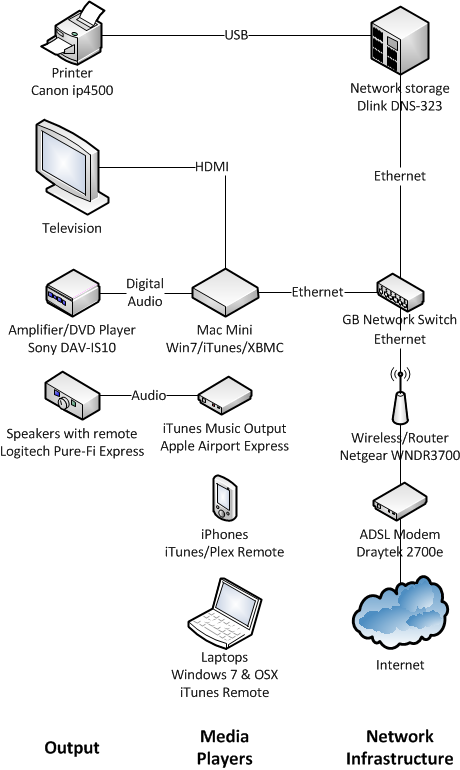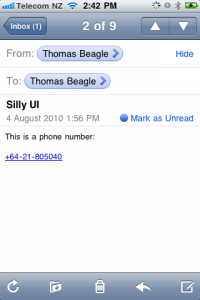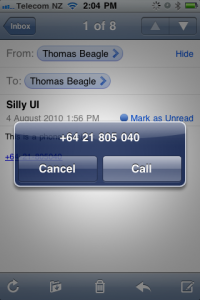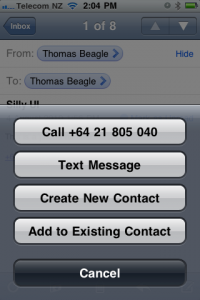Archive for the Tech Category
It’s the end of the iPhone era for me.
I had been pretty impressed with the US iPhones that had leaked into NZ, and I bought an iPhone 3G on the first day they were available in NZ (using my own money even!) and upgraded it to a 3GS soon after that came out.
And it was great. Apple really were the first people to get the smartphone right. It was fast, had a useful screen and the touch interface had Apple’s usual attention to detail. My iPhone and I had a lot of good times together.
But by the time the iPhone 4 was released I just wasn’t as interested. It wasn’t just the hardware, or Apple’s control-freakery or any one thing in particular, but somehow I wanted to try something else.
What did happen was a Samsung Galaxy S II running Google’s Android operating system. I’ll be writing more about that later, but first I thought I’d finally get around to publishing my list of iPhone gripes.
These are my personal gripes. I know that some of them are probably features to other people, or can be fixed with more or less ease, or will be fixed in iOS5 but it’s really too late for that for me. So, in no particular order, a bunch of things that annoyed me about the iPhone:
- The failure to use the lock screen to display useful information.
- The way the weather app icon doesn’t change to match to match the weather.
- That the Maps icon is an American highway map.
- The difficulty of finding good apps – you can find a multitude of apps but it’s very hard to tell which are any good.
- The “icons, icons, nothing but icons” menu system.
- That the iPhone 3GS had very limited message notification and ringtones. You hear that “ding-ding” sound and every iPhone user in the room wonders if the message is for them.
- The way that iOS4.2 added new message tones for the iPhone 4 but not for the older 3GS.
- The lack of buttons, particular the way that the single button is used for search, task-switching, app-closing, and screen shots (about 10% of my photos are accidental screen shots),
- The lack of a physical camera button. Trying to do tricky shots wth the on-screen button is hard.
- The multi-second delay in starting the camera.
- The way that Apple offered free iPhone tracking… for the iPhone 4 but not the 3G or 3GS.
- The volume and mute controls on the 3GS have annoyingly sharp edges – and the mute button is too easy to activate when putting it into a pocket.
- There’s no icon on screen to show whether mute is on or not.
- That the iOS4 ‘upgrade’ killed the performance of the iPhone 3G and 3GS and Apple tried to stop you downgrading again. (This was improved in later versions but the performance is still noticeably crappier than it was.)
- The way that the 3G doesn’t get security fixes any more after just two years. (Launched July 2008, last fix Nov 2010).
- Apple choosing what political views are acceptable in apps sold in the app store – and there’s no other way to get apps.
- The inability to cache downloaded maps on your phone.
- The rotation-lock option cunningly hidden in a leftward swipe of the dock-thing when in task-switching mode.
- That you have to install iTunes to activate the phone or copy music to it.
- If you switch to a new PC, iTunes tries to get you to wipe everything from your phone (this can be prevented).
- That you can’t use the volume controls for page turning when reading electronic books.
- Lack of easy auto update for applications.
- If you’re in one application and click a link that takes you into another (e.g. a YouTube video link in the browser), there’s no obvious way to get back to where you were in the first application.
Coming soon: my list of Android gripes. :)
Three and a half years ago I documented my home entertainment system. I thought that people both technical and non-technical might appreciate the chance to see how someone else had done it.
It’s time for an update. Let’s start with what we can do with it:
Features
- Lounge – we use XBMC on the Mac Mini to play music, downloaded media and streaming Internet video. The all-in-one DVD player/amplifier is still used to watch movies on DVD.
- Bedroom – we use an Airport Express to play music from the network storage via iTunes running on the Mac Mini in the lounge. Our iPhones are used as remote controls. (Yes, there are a lot of systems involved in that process. Amazing that it works so well!)
- General – centralised storage of data, printing from anywhere, wireless Internet.
The Diagram
And here’s all the bits and how they connect up. As you can see it’s organised into three columns – output devices, players and network infrastructure:
Major Changes
The major changes since the last update:
- Dumped the old Xbox hardware for a media player and replaced it with an only slightly broken surplus Mac Mini running Windows 7. It’s still running XBMC. (Plex on OSX was rejected due to being a bit too unfinished – and I ended up hating the Apple Remote for not having enough buttons.)
- Upgraded the wireless network to dual-band 802.11n and the wired network to gigabit ethernet for maximum performance.
- Upgraded the network storage from 2 x 500Gb drives to 2 x 1.5TB drives, while still using the same old Dlink DNS-323 hardware.
- Switched to an ADSL internet connection due to not being able to get cable any more. We ended up having to run PPPoE from the ADSL modem to the router to make the connection stable enough to use.
- Added iTunes on the Mac Mini to enable use of an Airport Express as a remote music player.
- Added a Logitech Harmony remote (not shown) to control it all. This has allowed us to dump the other three remotes into a drawer and ignore them.
- Added an Xbox 360 (not shown) for gaming.
Next
It’s all working pretty well at the moment so no major changes are planned. The only limitation is that the Mac Mini isn’t powerful enough to play high-quality 1080p video. This could be solved by upgrading the hardware or by replacing it with a dedicated media player – if they ever get good enough (keeping my eye on the Boxee Box and the WD Live Hub). It doesn’t worry me too much at the moment.
Questions?
Feel free to ask any questions and I’ll do my best to answer them.
I really like the way that the iPhone recognises phone numbers in emails and turns them into touchable links.
But for ages I thought that all you could do was call the number.
This used to really annoy me because, being a modern kind of person, I generally prefer to text people than call them. Other times I just wanted the number to add to my address book, so I’d end up cutting and pasting the number into Contacts.
Then one day I lingered on the link too long and a whole new menu popped up! Hey, here were exactly the features I was looking for.
Now, there are two problems here.
Firstly, there is no advantage to the user from this arrangement. In both cases the phone displays a menu with one or more actions and an option to cancel it. The required user actions are the same:
- Press (or press and hold)
- Press selected option or cancel
If the user interaction is exactly the same why not just show the full menu in both cases?
Secondly, and more importantly, this “press and hold” functionality is hidden from the user and there’s no way to easily discover it. I’d had my phone for a couple of years before I realised it was there (I’m assuming it wasn’t added in an OS upgrade) and I wonder how many people still don’t know about it. And what other convenient features am I missing just because I haven’t thought to check that they might be there?
To my mind, “press and hold” is a user-unfriendly way to add functionality and should be avoided wherever possible.
(This is another in my series of posts where I record my current feelings about technology in order to have something to laugh at in five years time. See also What I Use and Market Calibration.)
I’m getting urges for a new laptop again.
The main requirements when I got this laptop (Compaq 2510p) were:
- Small and light-weight (it’s 1.4kg)
- Long battery life (~6 hours)
- Runs Windows well (it’s part of my job)
The Compaq has worked pretty well for me but my biases are changing. My new requirements are:
- Relatively lightweight (but not so worried about small any more)
- Backlit keyboard (I do quite a lot of writing at night but I don’t touchtype. A backlit keyboard would make both Kim and me happier.)
- High resolution screen (at least higher than the current 1280×800)
- Well over four hours useful battery life (i.e. I might accept four but I really want more)
- I’d still choose battery life over performance and I’d prefer it not to have an optical drive to save weight.
And while it’s not necessary, I suspect that any laptop that meets those criteria will have one of the much cooler solid-state hard drives. They’re lighter and use less battery, plus they have no moving parts so they’re more reliable.
When it comes to the operating system, while I’d like to have a proper go using Mac OSX, Windows 7 fulfils most of my requirements and is more appropriate to my job.
Finally, it’d be nice if it looked kind of stylish, maybe even with a bit of colour.
Contenders
I recently had a play on a Dell Latitude Z600 and I have to admit it was pretty good even though it was much bigger than anything I’ve considered before. It’s thin and surprisingly light for its size. Sadly, while the 16″ screen at 1600×900 has more pixels than my current screen, you’d think they could have increased it even more. Unfortunately it costs an ungodly amount of money and I believe the battery life is apparently atrocious.
The HP Envy 13 also looks pretty good. Stylish, good screen (1600×900 is acceptable on a 13″ screen), good battery life – but no backlit keyboard.
Dell have just put out the Vostro V13 at a good price but I really don’t want to stay with a standard res screen and no keyboard backlight.
The Sony Z is rather cool. 13″ screen at 1600×900, good battery life, backlit keyboard… why not? Sadly I have absolute faith in Sony’s ability to screw it up by filling it full of crap software and failing to provide good hardware drivers. It’s a pity because otherwise I think it might be the winner.
When it comes to the Apple range, the MacBook Pro 13″ is rather nice (and the price recently dropped). It fulfils most of my requirements (except screen resolution) but the styling is looking a bit dated and I don’t trust Apple to do a good job of releasing drivers that will allow Windows 7 to work to its full potential.
As normal, I find myself wishing I could cut’n’paste features from multiple models so that I could end up with the perfect laptop!
Late addition
I ended up with the Sony Vaio Z (the high-end version with a 1920×1080 screen, 8GB memory, 256GB SSD, etc). It’s a very nice laptop but my fears that Sony would do their best to screw it up were not unfounded. It came with 9 ugly stickers as well as a whole load of badly written Sony software pre-installed. Luckily that could all be cleaned up and I’m really very happy with it.
The other day I was reflecting on the multitude of technological tools and services I use in the course of my day to day life. Some that seem vital to me today (e.g. Gmail) didn’t even exist a few years ago, while others that were so important to my life in the past (e.g. Usenet) I haven’t with bothered with for ages.
I thought it might be interesting to record what tools I currently use and how I use them. Ideally I could update it every year or so and thereby create a personal technological timeline.
And my first thought on looking at it? “Gosh that’s a long list.”
Continue Reading “My Technology : Point in Time” »
Currently I’m prepared to spend (all NZ dollars):
- about $5-15 for an ‘album’ worth of music. But only if it’s high-quality and unencumbered digital files. I don’t want your bits of plastic or your DRM.
- up to $25 on a physical book. But I use the library more.
- up to $10 on an electronic book, even if it’s encumbered and locked to my reading device. I’d consider paying more for an unencumbered one.
- up to about $40/year for access to a good website or online service (e.g. salon.com or fitday.com).
- up to $10 for an iPhone app, or up to $5 if it’s pretty trivial.
- $15 to see a movie or $17.50 if it’s in 3D. (Although I normally go on cheap Tuesday.)
- $10 to rent a movie on DVD or online.
- $1-2 for a downloaded TV episode.
Naturally it’s all subject to change. I used to pay $30 for a music CD!
My first computer was a 1990 i386 with 2MB of memory and an 80MB hard drive, scrounged from the offices of a local shipping company. Complete with serial mouse, IBM Model M keyboard, and 15″ color VGA monitor, it was my parents’ hope for making me into a competent writer, but it better succeeded in making me a PC gamer. This ancient machine, 17 years old, is incredibly outdated in the physical basis of every technological detail, except one: its hard disk.
This is the introductory paragraph for a rather lightweight article about hard drives. It’s also a great example of a writer saying something obviously stupid purely because it suited the rhetorical framework that they had chosen to use.
Yes, the hard drive does still take the basic form that it did 17 years ago. But when kept to the same level of required similarity, so does the memory, the CPU, the motherboard, the case, the power supply, and the keyboard. Indeed, the only two major physical design changes I can think of when it comes to the common PC is the replacement of ball mice with optical mice, and the rise of the flat-screen LCD monitor.
Don’t you just hate it when reality gets in the way of a good line?
Ah, IT commentators, some of them are so young. About Microsoft:
They’ve got this new “consumer” bug where they think they’ve got to be a player in every consumer market. I think they would be better served sticking to their enterprise roots and not chase every consumer trend.
Enterprise roots? Microsoft may be the company that ended up changing how enterprises (I don’t like the term and it hurts me to use it but it’ll have to do) implemented IT but it took a long time to happen and they definitely didn’t start there. Indeed, the enterprise fought against Microsoft and their silly PCs for quite a while, and even when they let PCs in to the front office they still weren’t prepared to let Microsoft into the datacentre.
If you had to pick a term, “hobbyist roots” would probably be more accurate.
In an earlier post I complained about Vodafone’s rapacious pricing of casual data rates ($11000 per GB).
Now in the comments at this post from Rob Drury we get the Vodafone PR guy Paul Brislen boasting that “The front page of Stuff alone would cost a fortune to open…”
So, he’s using his company’s unconscionable pricing model to justify providing their own limited walled garden (Vodafone Live) that they just happen to make lots of money with.
They really do have no shame.
Microsoft have included the IDT High Definition Audio CODEC as an optional update within Windows Update. Installing it killed my audio as it has done for a number of other users.
I’d recommend not installing it for now.
(I ended up fixing it by uninstalling it and reinstalling the Dell audio drivers from scratch. Other options would be using System Restore to go back to before you installed it.)
I’m kind of disappointed because Windows Update has always been so amazingly solid for me in the past.




